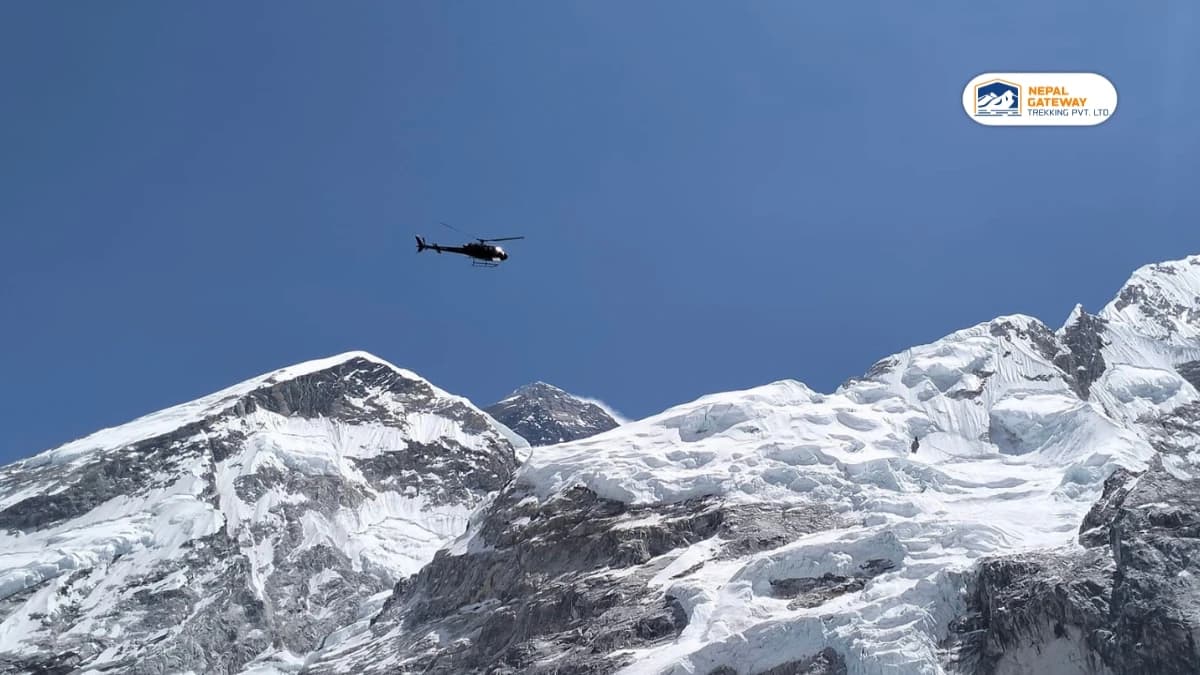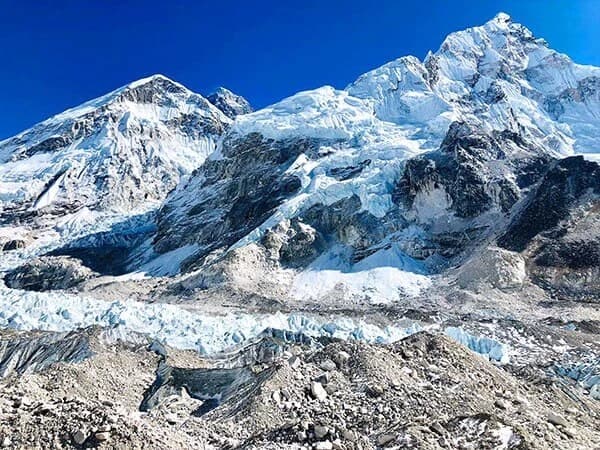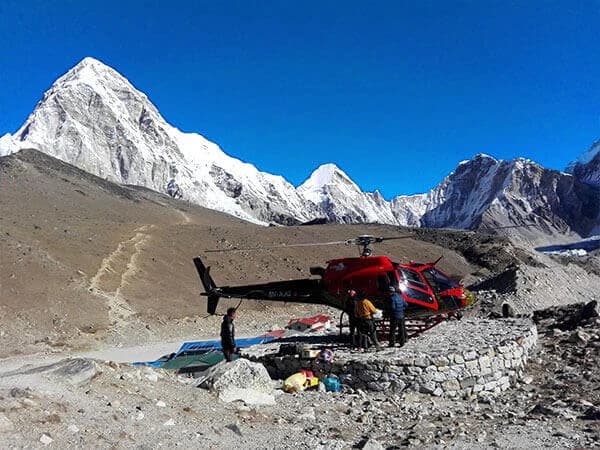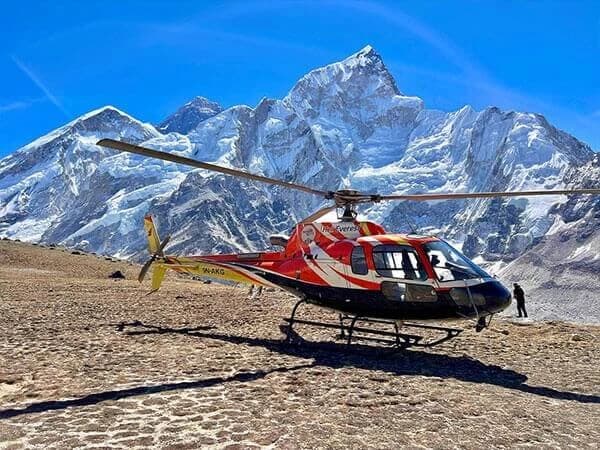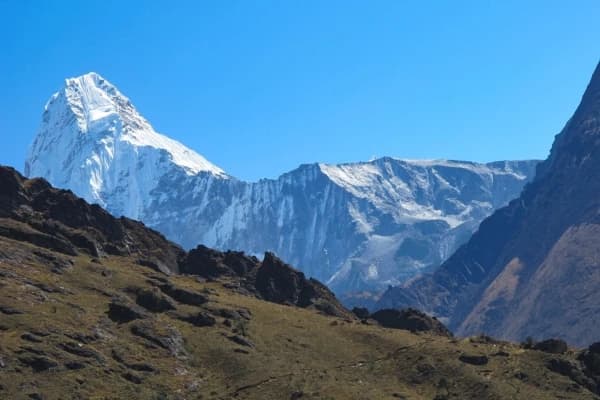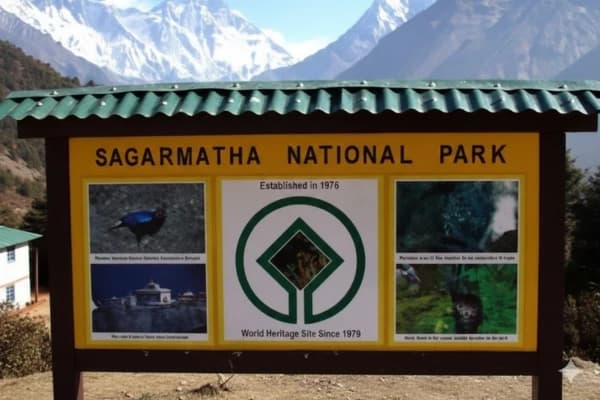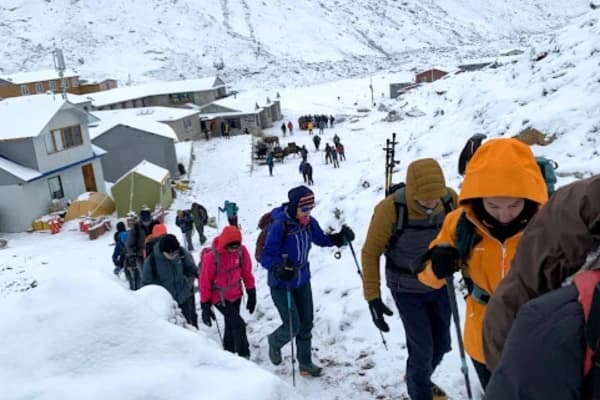The best time for Everest Base Camp Helicopter Tour is generally around spring (March to May) and autumn (September to November), as they offer an unobstructed view and a blinding golden hue on the mountains at the right time. The skies around these periods are often crystal clear, offering unhindered panoramic views of the Everest range.
Thinking of flying to the Everest Base Camp for jaw-dropping Himalayan peaks without the trek?
You’re not alone. Thousands of travelers long for the Everest experience but don’t have weeks to hike. A helicopter tour to Everest Base Camp is the perfect solution as it is quick, thrilling, and full of unforgettable sights.
But here’s the thing: timing matters by a significant margin. Book at the wrong time, and clouds might block the grandeur of Everest, or strong winds could ground your flight. It can turn an epic journey into a letdown.
So, when is the best time for the Everest Base Camp Helicopter Tour?
Let’s break it down and help you plan the most spectacular ride of your life, including mountain peaks, glacier landscapes, popular landings, and blue skies.
Take the classic route to Everest Base Camp and skip the return hike with a thrilling chopper ride—discover the best of both worlds on the Everest Base Camp Heli Trek.
Highlights of the Everest Helicopter Tour
The helicopter tour to Everest Base Camp is the best way to enjoy a mesmerizing and mystifying sight of the Everest region in a short duration. Some of its most standout highlights are:
- Aerial view of Everest, Ama Dablam, Lhotse, and other significant Himalayan landscapes.
- Close-up view of Everest from Kala Patthar Landing (5,545m), the best Everest viewpoint.
- Stunning sights include the Khumbu Glacier, icefalls, and more.
- Fly over iconic Sherpa villages like Namche Bazaar and monasteries alike.
- Panoramic landscapes of Sagarmatha National Park
What Seasons Offer the Safest Skies for Everest Helicopter Flights?

Spring is considered one of the safest seasons, so it is one of the best time for Everest Base Camp Helicopter Tour. With almost no rainfall, like in the monsoon season, spring offers clear visibility and stable weather. Due to low wind and less turbulence, helicopter flights are smoother during the spring season.
As for the autumn season, this season is right after the monsoon season, so rainfall ends, and the sky gets clear and fresh. This makes it easier for pilots to navigate through the tour more easily. Wind speed and weather disruptions are generally low, making flight cancellations rare.
The autumn season offers the best visibility of the year, making it the perfect season for photography and mountain viewing.
Spring (March to May) – Blooming Beauty and Blue Skies
Spring brings life back to the Himalayas. From March to May, skies are often clear, flowers are blooming, and the landscape looks vibrant from above.
What's great:
- Stunning views of blooming rhododendrons and lush hills
- Mild temperatures are ideal for the heli tour
- Stable visibility and a clear mountain range
- Great for photography and comfort travelers
Things to keep in mind:
- Slightly busy due to the popular trekking season
- May can start to get hazy later in the month
Autumn (September to November) – The Golden Time
Autumn is the top-rated season best time for Everest Base Camp Helicopter Tour of your priority is photography, and is your first time to Everest. The monsoon has cleared the dust and clouds, and the mountains stand out in full glory.
Why it’s awesome:
- Perfect weather with crisp air and brilliant visibility
- Fewer chances of weather disruptions
- Best season for Everest photography
- Ideal conditions for first-timers and families
Possible downsides:
- Peak demand means limited availability and slightly higher pricing
- Crowded trails in popular spots
Is the EBC Helicopter Tour Doable in the Off-Season?
It is very much possible to do the Everest Base Camp helicopter tour in off-seasons like winter and monsoon. But there are limits to what can be and cannot be done. The weather can be tricky, and flights may not always go as planned.
You might need to wait days if there is bad weather.
While EBC helicopter tours are technically possible year-round, peak seasons (spring and autumn) are much more reliable. If you're considering a winter or monsoon tour, be prepared for weather-related changes and frequent flight cancellations. So carry warm clothes, or down jackets.
Plan Your Trip with Nepal Gateway Trekking, which monitors conditions carefully.
Monsoon (June to August)
If you are considering touring in Monsoon then it might not be the best decision as the likelyhood of EBC Helicopter Tour getting canceled is very high. It’s the season where there is heavy rain, cloudy skies, and low visibility on a daily basis almost. Flights often get delayed, and views aren't always clear.
What’s good in Monsoon:
- Green landscapes and unique views
- Fewer tourists around
What challenges can come :
- High chance of flight cancellations due to clouds, rain, or storms
- Poor visibility
- Risk of landslides and unstable air
Witness Mount Everest up close in just a few hours with the thrilling Everest Helicopter Day Tour—perfect for those short on time but big on adventure.
Winter (December to February)
Winter is cold, especially if you are not used to that kind of weather. The Himalayas can be exhausting from sheer cold alone if you are not fully prepared. But since the climate is cold during this season, the route is normally almost empty, and accommodations are available, even if limited.
Better Points:
- Quiet trails and clear skies on sunny days
- Less crowded skies and accommodations
Challenges:
- Freezing temperatures, especially during early mornings
- Possibility of snowstorms and delays
Month-by-Month Breakdown Overview for EBC
The best month to decide on the EBC Heli Ride depends on what you seek. Each month offers a different kind of experience, and at the same time has some drawbacks. Here are some of the best months for your tour.
- October – Best visibility, calm skies, and stunning mountains and glaciers.
- April – Rhododendron blooms meet clear skies for a colorful scenic ride.
- November – Crisp air and golden hues make for breathtaking aerial views.
- March – Warmer weather and thinner crowds offer a peaceful experience.
- December – Skies stay clear, but temperatures drop to extreme lows.
- May – Views are decent, though mild haze can dull the sharpness.
- February – Visibility can vary; expect surprises in weather.
- September – Monsoon fades, with improving skies and fresh greenery.
- January – Clear skies but freezing conditions challenge comfort.
- June to August – Heavy rains, clouds, and flight cancellations, so skipping is best.
If you're planning your journey to the Himalayas, learn the best time for Everest Base Camp trek to ensure you hit the trail at the perfect moment. We also have a table showing the average day and night temperatures as well as their overall weather conditions below:
|
Month |
Avg. Day Temp |
Avg. Night Temp |
Remarks |
| March |
7°C |
-12°C |
Cold but stable views |
|
April |
10°C |
-5°C |
Warm and colorful |
|
May |
12°C |
0°C |
Warmer, some haze |
|
June |
14°C |
2°C |
Start of monsoon |
|
July |
15°C |
4°C |
Monsoon rain & fog |
|
August |
14°C |
3°C |
Still wet and cloudy |
|
September |
13°C |
1°C |
Clearer skies begin |
|
October |
10°C |
-3°C |
Best visibility |
|
November |
6°C |
-10°C |
Crisp and cool |
|
December |
4°C |
-15°C |
Very cold, peaceful |
|
January |
3°C |
-17°C |
Coldest month |
|
February |
5°C |
-14°C |
Dry and cold |
If you love trekking, the Everest Base Camp Trek is the ultimate adventure—offering rugged trails, breathtaking scenery, and an authentic Himalayan experience.
How to Choose the Best Time for EBC Helicopter Tour?

Choosing the best time for Everest Base Camp Helicopter Tour isn’t just about the weather; it's about finding the balance between comfort, budget, your travel goals, and the views you get at the time. Let us explain why some of these factors matter a lot most of the time.
Budget
Prices rise during peak months due to high demand. If comfort is your priority, then you should book in the best season, but for more budget-friendly options, try off-peak months like March or November.
Weather Condition
Clear skies are really important for safe helicopter flights. During monsoon and heavy winter, flights often get delayed. But in spring and autumn, the skies are clear and the views are amazing.
Flight or Road Transport
Flights to Lukla may be affected by seasonal weather, impacting the entire tour schedule. So, choosing the seasons that have the most optimal weather for your goals will be a good thing.
Trail Condition
Although this is a helicopter tour, snowy or rainy trails might affect ground handling, especially at Kala Patthar. It is nearly impossible during the monsoon, as there is constant danger of sudden heavy rainfall and snowstorms in the winter.
Crowd
Spring and autumn are the peak seasons, bringing more people to the region. If you seek peaceful viewpoint areas, want less crowded sightseeing, or want readily available accommodations, consider winter months.
Personal Preferences
Some prefer flowers, others clear skies or peaceful trails. You may want a clear view of the Himalayas and Mount Everest, then it's best to choose the season that matches your travel goal.
Traveller’s Tips to Have the Best Trip of Your Life
Going on an adventure to Everest Base Camp is more than just booking a trip; it takes smart planning. From picking the right guides to knowing what to pack, every little thing counts. Here’s how you can have the best time for Everest Base Camp Helicopter Tour.
Choose the Right and Best Trekking Company
The tour company you choose matters a lot when travelling to the Himalayas. You have to choose the one who has safety records and is licensed. At Nepal Gateway Trekking, we handle all logistics, safety, and permits, so you have a stress-free trip.
Selection of Lodges
Choosing quality lodges makes your trip comfortable, even in remote high places. Prices vary, but picking well-kept spots with strong local ties greatly helps. Nepal Gateway Trekking will help with those local connections to make your journey smooth and authentic.
Packing the Right Gear
Having the right gear isn’t just about feeling comfy-it’s essential to stay safe and do your best when you’re way up high. The wind gets really cold at those altitudes, and temperatures can drop fast, so you have to be ready.
That means packing sturdy shoes, a jacket that blocks the wind, and sunglasses that protect your eyes from the intense sun. Wearing these will help you enjoy the Everest Base Camp Helicopter Tour to the fullest.
Acclimatize and Learn About AMS
The tour lasts 7–8 hours, but altitude can still affect you. Acute Mountain Sickness (AMS) happens when your body struggles to adjust, causing headaches, nausea, or dizziness. Knowing these symptoms helps avoid cancellations. Stay hydrated, rest, and follow advice from experienced travelers to stay safe.
After experiencing Everest, you might be interested in the Langtang Helicopter Day Tour—a stunning aerial journey over the beautiful Langtang region, offering breathtaking views and a unique perspective of the Himalayas.
Final Thoughts
The best time for Everest Base Camp Helicopter Tour depends on what you want to experience and your budget. If you want clear views, solitude, or budget comfort, Spring and autumn would be the most ideal seasons for EBC Heli Tour. However, even the off-season has its charm if you’re prepared.
Book with Nepal Gateway Trekking to ensure your adventure is safe, scenic, and unforgettable.
FAQs
Can you take a helicopter to Everest Base Camp?
Yes! You can take a helicopter directly to Everest Base Camp or combine it with a trekking route. A growing number of travelers now prefer the Everest Base Camp tour and return back by helicopter for both comfort and speed.
What is the best time for Everest Base Camp Helicopter Tour?
The best time for Everest Base Camp Helicopter Tour is during spring (March-May) and autumn (September–November), when the skies are clearest and mountain views are most reliable. These seasons ensure safety, visibility, and a smooth flying experience.
How long is the tour to Everest Base Camp?
The entire helicopter ride from Kathmandu to Everest Base Camp and back takes about 4 to 5 hours. This includes aerial sightseeing and landing at Kala Patthar for photos and acclimatization.
Do helicopter flights land at Kala Patthar or Base Camp?
Most Everest Base Camp helicopter landing tours stop at Kala Patthar (5,545m) due to better viewing angles and safer landing conditions. Base Camp landings are restricted or weather-dependent.
Is the helicopter safe at high altitude?
Yes, helicopters used in the Everest region are specially designed for high-altitude flying. Pilots are experienced, and emergency oxygen is always available on board.
What permits are needed?
You’ll need the Sagarmatha National Park Permit and a TIMS (Trekkers’ Information Management System) card. Tour companies usually arrange both for you.
Is altitude sickness a concern?
Helicopter tours offer short exposure to high altitudes, minimizing the risk. Still, staying hydrated and flying during the best time for Everest Base Camp Helicopter Tour lowers the chance of altitude-related discomfort.
Can you trek and return by helicopter?
Absolutely! Many people opt for the Everest Base Camp tour and return back by helicopter, which allows them to enjoy the best of both trekking adventure and luxurious return.
